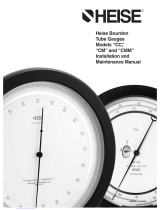
11412101 09/2009 GB/D/F/E
WIKA Operating instructions intelliGAUGE Model PGT15 (LOG-1x)
6
GB
3. Installation instructions
Effects of temperature
The mounting of the pressure instrument has to be done in a way that the
operating temperature is neither exceeded nor falls below the permissible
operating temperature, even in consideration of thermal convection and
thermal radiation. Tailpipes of a suitable length or syphons may be used
to protect the pressure instrument and the isolating device.
The influence of the temperature onto the accuracy of indication and of
measurement has to be noticed.
Diaphragm seal / protective barrier
In case of aggressive, hot, highly viscous, contaminated or crystallizing
pressure media, which must not be allowed to intrude the measurign
element, diaphragm seals have to be used as separating barrier. A
neutral transmission fluid, used to transmit the pressure to the measuring
element, should be selected in consideration of the measuring range, the
temperature and its compatibility with the pressure media.
The connection between the pressure gauge and the diaphragm seal
must not be released by no means.
Protection of the measuring element against overload
If the pressure media is subject to rapid pressure changes or pressure
impulses may be expected, these must not act directly upon the measu-
ring element. The effect of pressure impulses must be damped, e.g. by
installing an integrated restrictor screw (reduction of the cross section
in the pressure channel) or by connecting an adjustable throttle device
in series.
Pressure test connection
The pressure test connection, with a sufficiently large bore size (≥ 6 mm
diameter), should be arranged, as far as possible, over a shut-off device,
in a position where the accuracy of the reading will not be affected by the
flow of the media being measured. The pipe between the pressure test
connection and the pressure instrument should have an inner diameter
large enough to avoid blockages or delays in pressure transmission. Also
it should not have any sharp bends. It is recommended that it is mounted
with a steep incline of approx. 1:15.
Piping
The piping should be arranged and fitted so that it can withstand the
stresses caused by expansion, vibration and the influence of heat. When
the media is gaseous, a water drain point should be provided at the
lowest point. For liquid pressure media, an air bleed should be provided
at the highest point.











